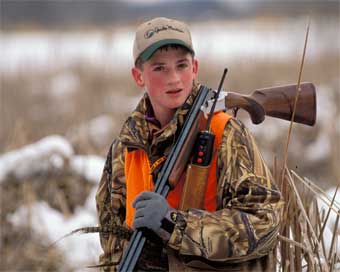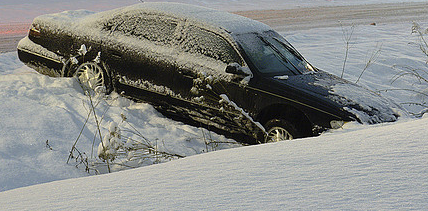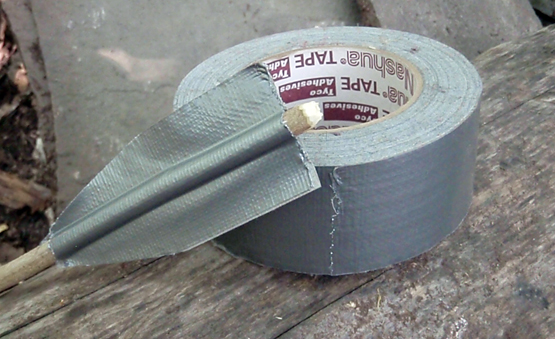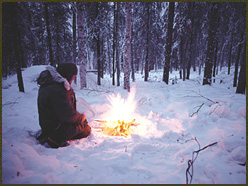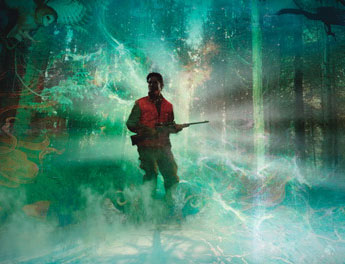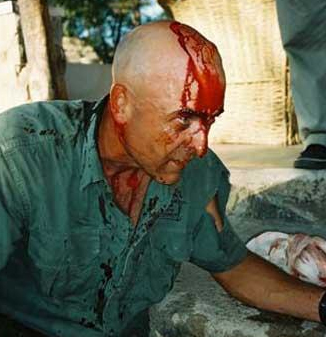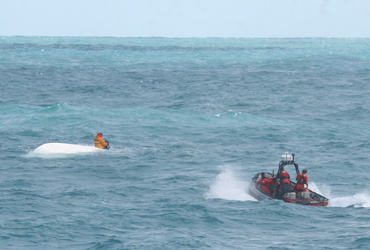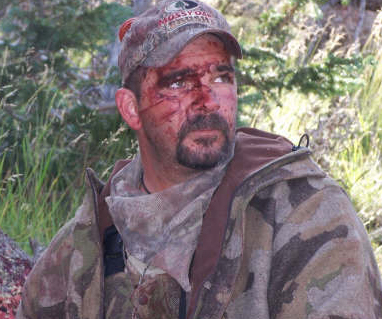A MAINE GUIDE, aCoast Guard search-and-rescue specialist and an Air Force survival expert.Those are the pros who make up the Outdoor Life Survival Team. Their combined58 years of outdoor survival experience provide a wealth of knowledge thatcould mean the difference between life and death the next time you goafield.
Q | In yourexperience, how do most problems in the wild start?
A | The problem Iencounter most often is a person getting lost. On a bear hunt, people stay outuntil a half hour after sunset, so it’s easy to miss a trail on the way back.If you walk 20 minutes in the wrong direction, you can get a long way from theroad.
Other things canhappen, too. One hunter fell out of a tree stand last year and broke his arm.He used his cell phone to call his nephew, and asked him to call for help. Butthe nephew just laughed because this guy’s always pulling jokes. He had to makeanother call to get help.
Q | Whatequipment should outdoorsmen carry that would be useful to them in a survivalsituation?
A | For each typeof activity–whether it’s flyfishing from a canoe, snowshoeing or following agame trail–there’s a different list of equipment. A life jacket, a compass, aGPS, waterproof matches, a fire starter, proper clothing, food and a first-aidkit are the givens. But for a January icefishing trip a hundred miles north oftown, you could need two spare tires, extra gas, an air compressor, an extrabattery, a sleeping bag…the list goes on.
From mystandpoint, the most important thing is a written checklist of everything thatmust be secured before the trip. Trying to remember what you need to gather isnearly impossible. If you’ve got it written down, you can’t forget anything.You can prepare a general list, but it’s important to keep in mind that eachactivity has its own requirements. Sometimes it’s 90 degrees and sunny, andsometimes it’s 30 below and there’s a foot of snow and the wind’s blowing, soyou’ll need a different list for each activity. Check off everything to makesure you have it before you leave.
Q | What shouldsomeone do if he finds himself in a potential survival situation?
A | The firststep is to stop, assess the situation and avoid panic. The second step is totake care of any injuries. The third, whether you’re alone or with a partner,is to make a plan and carry it out. And fourth, depending on the predicament,you’ll have to decide whether to stay where you are and wait for help or go formedical assistance by the safest and fastest route possible. In all situations,panic is most often the reason people get into trouble. Trying to avoid panicis the biggest challenge. When the sun goes down and the wind’s blowing and youdon’t know where you are, the ability to avoid panicking is not a given.
Q | I assume thatthinking things through helps to keep a person calm.
A | Yes, it does.Once you think things through and have a plan, at least you’re able to collectyour thoughts. Sit down and say to yourself, “Step by step, what am I goingto do?” I know of a man who went hunting within three miles of town wearingrelatively light clothing. A freak storm came in and he got lost. He built afire and did everything he’d been taught to do. Then a train came by on a tracknot a quarter mile from where he was and blew its whistle. He just took off,left the fire and his rifle, and went after that whistle. They found him thenext afternoon, nearly unconscious. The ability to make a plan and stick withit is the number-one priority.
Q | How can asurvivor assist in his own rescue?
A | The foremostthing is to have a plan and let somebody know where you’re going to be and whattime you’re planning to be back. That way, rescue can start at a given time andplace. When you come to the conclusion that you’re lost, build a fire and stayput. Don’t go wandering around.
Everyone thinkshe should fire three shots if he gets lost. I’ve had hunters lose their way inthe middle of the afternoon and fire off all their rounds trying to attractattention. People who hear those shots just think somebody’s into a bunch ofdeer. Nobody’s really looking for somebody to be lost in the middle of theafternoon.
At night, whenshots wouldn’t be fired at a deer, it’s a different matter. I’ve gone aftershots fired at night, and the hunter was so far away, his .30/06 sounded like aBB gun. But if you let someone know where you’re going to be and what time toexpect you back, that’s the first step. Then, when you’re overdue, stay put andstart a fire. You’ll be easier to find.
Q | What aboutpreparation and planning to help stay out of trouble?
A | It’s allabout the four P’s: Preparation Prevents Poor Performance. Be prepared by usingan equipment checklist. If possible, recreate with a partner or a group. Checkthe local weather report, and dress and travel accordingly. Recreate withinyour ability level. If you are going to be in an area where there is cell phonecoverage, by all means take the phone with you. A satellite phone will put youin touch with help no matter where you are, so if you can afford it, buy orrent one.
Q | How can aperson prepare mentally for the psychological stress of a survivalsituation?
A | The abilitynot to panic will come with confidence in your skills and knowledge of theoutdoors. Book knowledge is a big help, but outdoor knowledge is priceless.Each time you pull your compass from your pocket and use it to travel 500 yardsto a road, or build a fire to cook a hot dog, or look at the sun and yourcompass to determine what time it is and then confirm it with your watch,you’re one step closer to having the confidence in your abilities to get youthrough a difficult situation.
Each day you’rein the outdoors, paying attention to what you’re doing, you’re one step closer.Do it until it’s instinctive, and your confidence will grow. And that will helpcontrol panic.
Q | Do you have apersonal survival story to tell?
A | Having guidedfor 45 years, I’ve been on a few late-night jaunts to gather up wet andconcerned clients. But the one that comes to mind was back in the mid ’70s,during a coon hunt on a rainy, 34-degree night. I was within three-quarters ofa mile of my pickup truck when my flash-light went dead. Reaching for my sparelight, I found that it was also dead. Trying to travel in the dark wasimpossible, so my next shot was to start a fire. No matches! But I did have a60-pound hound to help me ward off the rain.
I curled up undera blowdown, pulled the dog over my head to keep the heavy rain off and stayedthere until it was light enough to travel. It was a long time until daylight,but–other than being a little wet and cold, my pride was the only thing thatwas injured. I got out my compass and made it back to the road just fine.
Q | In your areaof operation, what are the most important things for an outdoorsman to considerto avoid a survival situation?
A | First, knowyour vessel. Many states now require a boating license. I highly recommendtaking a safe-boating course through either the Coast Guard Auxiliary or thePower Squadron–they are experts on boating safety. They will teach you what youneed to know in order to safely operate and navigate your vessel.
Next, check theweather. I have seen it go from perfect to Victory at Sea conditions in amatter of minutes. Don’t get caught in a storm. It’s as simple as that. We havea saying around here: “Bad things don’t happen in good weather.”
Finally, know theoverall condition of your vessel. Boats are much more fickle than a car or atruck. Unfortunately, some people jump behind the wheel of their boat much likethey would in their automobile. It is of the utmost importance to inspect yourvessel before leaving the dock. There is so much that can go wrong on thewater. Checking watertight integrity, fluid levels and the overall materialcondition will go a long way toward preventing a bad situation.
Q | Whatequipment should sportsmen carry to help save them in the event of a survivalsituation?
A | There areboth state and federal laws that govern required safety equipment on board yourvessel. They cover such things as life jackets, sound-producing devices, flaresand life rings. For a complete list of all required safety gear, you can visituscgboating.org or cgaux.org. Also, it’s a great idea to have the Coast GuardAuxiliary do a Vessel Safety Check on your boat. It’s free and coverseverything required by state and local laws. No citation is issued and theresults are not reported to any enforcement agency. If your vessel passes, adecal will be issued for you to display.
Another must isfiling a float plan with a friend or relative. Let that person know whereyou’re going and when you’ll be back. If nobody knows you’re late, nobody isgoing to come out to look for you. This step alone could reduce response timefrom days to hours.
Q | Step by step,what should an outdoorsman do who finds himself in a situation that is aserious threat to his survival?
A | In a distresssituation, the Coast Guard will ask you for what we call the “BigFour”: your position, the nature of distress, a description of your vesseland the number of people on board. Then we’ll tell you to put on your lifejackets.
The better youknow your position, the faster we can help. If you have a GPS on board, you canuse that to give us a location to within feet of where you are. This makesresponse time much quicker. You’d be surprised how many times we get a callfrom someone who needs help and can’t tell us where he is. We do our best tosort it out–it just delays the response time. If you’re caught in a situationthat’s life-threatening, put on your life jacket, call the Coast Guard andremain calm. Do not try swimming for shore or a structure; in the water, thingscan seem a lot closer than they actually are. You could tire yourself out, andyou’ll lose body heat faster.
If your vessel isoverturned, stay with it. Climb onto the hull, if possible. The more of yourbody you can get out of the water, the better. Of course, anti-exposurecoveralls or a dry suit will make your survival time that much longer. If yousee another vessel or an aircraft, use your flares. If a red flare is spotted,we will come out and try to find you.
Q | How can asurvivor assist in his own rescue?
A | It’s a toughthing to do, but you have to remain calm. If we’re trying to talk to you on theradio and you’re terrified and screaming (which does happen), it’s far moredifficult to get the information we need to help you.
Listen to whatthe person on the radio is telling you and answer the questions to the best ofyour ability. Some of the questions might seem repetitive, but it is allinformation we use to figure out how best to assist you. Remember, when someoneis on the radio talking to you, at the same time there might be a rescue boatbeing launched or a helicopter pulling its chocks coming out to help you.
Q | How can aperson prepare mentally for the psychological stress of a survivalsituation?
A | Being in thewater is scary. One thing we are taught in the Coast Guard is to develop a”survivor’s attitude.” Do your best to keep calm and positive. Ifyou’re with others, stay with them. Don’t separate. You’ll be much easier tofind as a group and you can help keep each other positive. The reality is thatsurvival time in the water is affected by what you’re wearing, your physicalcondition and how cold the water is. Although it would take a long time, youcan get hypothermia in 90-degree water. If, however, the temperature is below50 degrees, your survival time is much shorter.
Depending on howcold the water is, survival time might be only minutes after hitting the water.If you’re wearing a survival suit and are in a life raft, you may be able tosurvive for days.
Q | What kind ofsurvival situations have you been involved with?
A | I’ve run avast array of search-and-rescue cases since I’ve been in the Coast Guard. I’veseen everything from boat collisions to diving accidents. Without a doubt, thebest part of our job is saving a life. It’s what we train for every day. Whenwe get to put that training together to carry out a successfulsearch-and-rescue case, there’s no better feeling.
Q | What basicsurvival equipment should hunters and fishermen have with them at alltimes?
A | A map and acompass, a first-aid kit, water containers, sunglasses and sunblock, extraclothes and socks, extra food and a flashlight are a few basics you shouldalways have. Proper clothing is your first line of defense against theelements.
Make sure thatyou use the layering system–wicking, warmth and weather layers–so you can putthem on and take them off to adjust your body temperature. And don’t forget awarm hat–more than 60 percent of body heat can be lost through your head andneck. Also, be sure to have high-quality footwear and a pair ofmoisture-wicking socks.
Q | What are somethings to think about when assembling a survival kit?
A | Here are somebasic principles to bear in mind.
• Keep it simple,light and small. Take advantage of multi-use items.
• Keep a primarykit with all the basic components in a container or pack. Keep extra essentialitems (fire starters, a knife, a garbage bag, water storage/purification aids,signaling items) on your belt, in pockets or around your neck on parachutecord. Use lanyards to tie items to you and they will be there when you needthem.
• Customize yourkit to suit your environment.
• Base the kitupon your level of knowledge in using the items.
• Practice withthe equipment before you need to use it.
• Buy quality,proven products.
• Have brightlycolored items, so you can find them when you need them or if you drop them.
Q | What shouldpeople carry in a survival kit?
A | I recommendthe following:
• A qualityfull-tang knife and/or a multi-tool. Locking blades are an important safetyfeature.
• Extra-largegarbage bags for shelter, for water storage, to protect moisture-sensitiveitems, etc.
• An emergencyspace blanket.
• Waterpurification tablets.
• Tinder. I likecotton balls coated with Vaseline. They catch a spark easily, and can also beused to stuff a wound, treat chapped lips and dry skin or lubricate abow-and-drill socket.
• Fire starters.Ferrocerium rods create a spark of 5,400 degrees to ignite tinder. A cut pieceof hacksaw blade can be used as a striker and a saw. Wrap waterproof matches insome plastic wrap or store them in a case. A lighter with a clear housing tellsyou how much fluid is left. If the fluid runs out, you can still use thesparking element to start a fire.
• A bandanna. Useit as a sling, make a basket by tying knots in the corners, make a wounddressing or shred it for tinder.
• Genuine 550paracord.
• A buttoncompass.
• Acredit-card-size fresnel lens. Use it to start a fire, inspect a wound oridentify plants.
• Heavy-duty tinfoil can be used to make a cooking/storage container, a cup for boiling wateror a reflective signaling surface.
• A small LEDlight that has both a pressure-sensitive intermittent on/off pad and an on/offbutton.
• Snare wire tocatch small game, and for binding or making repairs.
• Signal mirrorwith sighting hole.
• Small plastic,pea-less whistle.
• Small spool ofdental floss to use as fishing line or sewing thread.
• Small fishhooks and sinkers.
• Heavy-dutyrubber bands for improvising traps or a slingshot.
• A fewheavy-duty sewing needles to use as primitive weapon tips or fishing spears(magnetize them to make a field-expedient backup compass).
• Safety pins tomake a treble-hook, for gigging, to secure items and for medical uses.
• Duct tape.
Q | Step by step,what should an outdoorsman do who finds himself in a situation that is aserious threat to his survival?
A | A mnemonic tohelp you remember the proper actions is the STOP acronym, for Stop, Think,Observe, Plan.
Stop: First,recognize early that you are in a potential survival situation. It is almostalways advisable to stay where you are, if you can. Many folks who get intotrouble in the wilderness do not take action early enough, and do not starttaking serious proactive measures.
Think: Second,think about what you need to do to help yourself. Breathe deeply and relax. Geta drink of water. Panic is your enemy. Folks who do not relax and think clearlyabout their situation have a tendency to panic and make rash, potentiallylife-threatening decisions.
Observe: Third,while thinking, observe your situation and the environment around you. Askyourself, “What got me into this mess, and what can I use to get out ofit?” Use all the information around you to help formulate the best courseof action.
Plan: Fourth,plan and prioritize your five basic needs: 1. Medical (psychological and physical health) 2. Personal protection (clothing, shelter, fire) 3. Sustenance (water, food) 4. Communication and signaling (letting search-and-rescue know you needhelp) 5. Travel (the decision to stay or move, based on your condition, situation,resources and whether or not help is coming)
Q | How can asurvivor assist in his own rescue?
A | Let rescuersknow where you are. Use the signal mirror and whistle from your kit. Thelongest recorded successful recovery using a mirror was more than 100 miles.Three of anything (blasts from a whistle, gunshots, fires) is the internationalsign of distress.
Send out aground-to-air signal in a clearing or on a high point that can readily be seenfrom above. The bigger it is, the better the chance of it being seen. Make sureit has good contrast against the background.
Sharp angles helpattract the the human eye. You can add meaning to ground-to-air signals byarranging them in certain configurations: X means “medical assistancerequired”; V means “assistance required”; an arrow means”proceeding in this direction”; Y means “yes”; N means”no.”
Use fire as asignal. Smoke and flames can be seen for miles.
Q | How can aperson prepare mentally for the psychological stress of a survivalsituation?
A | I believe 10percent is based on knowledge and skills, another 10 percent on equipment and80 percent on the will to live.
Don’t dwell onnegative things or feel sorry for yourself. Instead, think about things thatmotivate you, whether that’s your family, friends or faith. Those who maintaina positive mental attitude stand a much better chance of surviving than thosewho don’t. Your will to live is bolstered by practicing and studying as manysurvival techniques as you can. As my good friend, a survival enthusiast, oftensays, “You have to own your survival skills.”
Don Helstrom
Maine Guide To become a Maine Guide, you have to know more than just where the deer hangout. There are licensing and certification requirements for expertise in mapand compass use, lost-person and survival scenarios, navigation and even seakayaking. When clients follow Don Helstrom into the woods, they’re relying onhim to get them out alive. Don, who’s been guiding for 45 years, is certifiedas a Master Hunting, Fishing and Recreation Guide.
Kevin Buckwald
Coast Guard SAR Specialist Boatswain’s Mate First Class Kevin Buckwald is a U.S. Coast Guard Search andRescue expert with more than nine years of experience. The Coast Guard conductsa variety of missions along 95,000 miles of coastline in the continental U.S.,Alaska, Hawaii, Guam and Puerto Rico, as well as on rivers and lakes. Hismissions often involve rescuing outdoorsmen from survival situations innear-coast operations.
Joshua Anderson
Air Force SERE Specialist Tech Sergeant Joshua Anderson has been a SERE (Survival, Evasion, Resistanceand Escape) Specialist for more than four years. These Air Force survivalinstructors are among the world’s top experts at survival in arctic, desert,open ocean, jungle and mountain regions, in both combat and captivitysituations. The first book he read on survival was Bradford Angier’s How toStay Alive in the Woods, which he borrowed from his dad’s library.

